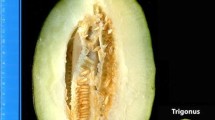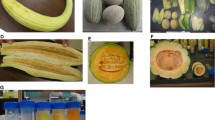Abstract
Two populations [an F2 and a set of 77 double haploid lines (DHLs)] developed from a cross between a ‘Piel de Sapo’ cultivar (PS) and the exotic Korean accession PI 161375 were used to detect QTLs involved in melon fruit quality traits: earliness (EA), fruit shape (FS), fruit weight (FW) and sugar content (SSC); and loci involved in the colour traits: external colour (ECOL) and flesh colour (FC). High variation was found, showing transgressive segregations for all traits. The highest correlation among experiments was observed for FS and the lowest for FW and SSC. Correlations among traits within experiments were, in general, not significant. QTL analysis, performed by Composite Interval Mapping, allowed the detection of nine QTLs for EA, eight for FS, six for FW and five for SSC. Major QTLs (R 2>25%) were detected for all traits. QTLs for different traits were no clearly co-localised, suggesting low pleiotropic effects at QTLs. Sixty-one per cent of them were detected in two or more experiments. QTLs for FS were detected in more trials than QTLs for FW and SSC, confirming that FS is under highly hereditable polygenic control. ECOL segregated as yellow:green in both experimental populations. The genetic control of ECOL was found to be complex, probably involving more than two loci with epistatic interactions. One of these loci was mapped on linkage group 9, but the other loci could not be clearly resolved. FC segregated as white:green:orange. The locus responsible for the green FC was mapped on linkage group 1, and it was proposed to correspond to the previously described locus gf. The genetic control of orange FC was complex: two loci in linkage groups 2 and 12 were associated with orange flesh, but larger population sizes would be necessary to elucidate completely the genetic control of orange flesh in this cross. Exotic alleles from PI161375 showed beneficial effects on EA, FW and SSC, indicating the usefulness of PI 161375 as a new source of genetic variability to improve European and American cultivars.

Similar content being viewed by others
References
Akashi Y, Fukunda N, Wako T, Masuda M, Kato K (2002) Genetic variation and phylogenetic relationships in East and South Asian melons, Cucumis melo L., based on the analysis of five isozymes. Euphytica 125:385–396
Basten CJ, Weir BS, Zeng ZB (1994) Zmap a QTL cartographer. In: Smith C, Gavora JS, Benkel, Chesnais J, Fairfull W, Gibson JP, Kennedy BW, Burnside EB (eds) Proceedings of the 5th World Congress on Genetics Applied to Livestock Production: computing strategies and software. Organizing Committee, 5th World Congress on Genetics Applied to Livestock Production, Guelph, Ontario, pp 65–66
Basten CJ, Weir BS, Zeng ZB (2002) QTL Cartographer, version 1.16. Department of Statistics, North Carolina State University, Raleigh, N.C.
Bernacchi D, Beck-Bunn T, Eshed J, Lopez J, Petiard V, Uhlig J, Zamir D, Tanksley SD (1998) Advanced backcross QTL analysis of tomato.: I. Identification of QTLs for traits of agronomic importance from Lycopersicon hirsutum. Theor Appl Genet 97:381–397
Chen FQ, Foolad MR, Hyman J, Clair DA, Beelaman RB (1999) Mapping of QTLs for lycopene and other fruit traits in a Lycopersicon esculentum × L. pimpinellifolium cross and comparison of QTLs across tomato species. Mol Breed 5:283–299
Cheng JF, Adelberg J (2000) Interspeciefic hybridisation in Cucumis-progress, problems and perspectives. HortScience 35:11–15
Churchill GA, Doerge RW (1994) Empirical threshold values for quantitative trait mapping. Genetics 138:963–971
Clayberg CD (1992) Interaction and linkage test of flesh colour genes in Cucumis melo L. Cucurbit Genet Coop Rep 15:53
Concibido VC, La Vallee B, Mclaird P, Pineda N, Meyer J, Hummel L,·Yang J,·Wu K, Delannay X (2003) Introgression of a quantitative trait locus for yield from Glycine soja into commercial soybean cultivars Theor Appl Genet 106:575–582
Dolcet-Sanjuan R, Clavería E, Llauradó M, Ortigosa A, Arús P (2001) Carnation (Dianthus caryophyllus L.) dihaploid lines resistant to Fusarium oxysporum f. sp. Dianthi. Acta Hortic 560:141–144
Emery GC, Munger HM (1970) Effects of inherited differences in growth habit on fruit size and soluble solids in tomato. J Am Soc Hortic Sci 95:410–412
Eshed Y, Zamir D (1995) An introgression-line population of Lycopersicon pennelli in the cultivated tomato enables the identification and fine mapping of yield-associated QTLs. Genetics 141:1147–1162
Frary A, Nesbitt TC, Frary A, Grandillo S, Van der Knaap E, Cong B, Liu J, Meller J, Elber R, Alpert KB, Tanksley SD (2000) fw2.2: a quantitative trait locus key to the evolution of tomato fruit size. Science 289:85–88
Fridman E, Pleban T, Zamir D (2000) A recombination hotspot delimits a wild-species quantitative trait locus for tomato sugar content to 484 bp within an invertase gene. Proc Natl Acad Sci USA 97:4718–4723
Fulton TM, Beck-Bunn T, Emmatty D, Eshed Y, Lopez J, Petiard V, Uhlig J, Zamir D, Tanksley SD (1997) QTL analysis of an advanced backcross of Lycopersicon peruvianum to the cultivated tomato and comparisons with QTLs found in other wild species. Theor Appl Genet 95:881–894
Fulton TM,·Grandillo S,·Beck-Bunn T, Fridman E,·Frampton A,·Lopez J,·Petiard V, Uhlig J,·Zamir D, Tanksley SD (2000) Advanced backcross QTL analysis of a Lycopersicon esculentum × Lycopersicon parviflorum cross Theor Appl Genet 100:1025–1042
Higashi K, Hosoya K, Ezura H (1999) Histological analysis of fruit development between two melon (Cucumis melo L. reticulatus) genotypes setting a different size of fruit. J Exp Bot 50:1593–1597
Hughes MN (1948) The inheritance of two characters of Cucumis melo and their interrelationship. Proc Am Soc Hortic Sci 52:399–402
Iman MK, Abo-Bakr MA, Hanna HY (1972) Inheritance of some economic characters in crosses between sweet melon and snake cucumber.: I. Inheritance of qualitative characters. Assiut J Agric Sci 3:363–380
Jeffrey C (1980): A review of the Cucurbitaceae. Bot. J Linn Soc 81: 233–247
Kearsey MJ, Farquhar AGL (1998) QTL analysis in plants: where are we now? Heredity 80:137–142
Kirkbride JH (1993) Biosystematics monograph of the genus Cucumis (Cucurbitaceae). Botanical identification of cucumbers and melons. Parkway, Boone, N.C.
Lander ES, Green P, Abrahamson J, Barlow A, Daley M, Lincoln S, Newburg L (1987) MAPMAKER: an interactive computer package for constructing primary genetic linkage maps of experimental and natural populations. Genomics 1:174–181
Liu J, Van Eck J, Cong B, Tanksley SD (2002) A new class of regulatory genes underlying the cause of pear-shaped tomato fruit. Proc Natl Acad Sci USA 99:13302–13306
Mliki A, Staub JE, Zhangyong S, Ghorbel A (2001) Genetic diversity in melon (Cucumis melo L.): an evaluation of African germplasm Genet Res Crop Evol 48:587–597
Monforte AJ, Friedman E, Zamir D, Tanksley SD (2001) Comparison of a set of allelic QTL-NILs for chromosome 4 of tomato: deductions about natural variation and implications for germplasm utilization Theor Appl Genet 102:572–590
Monforte AJ, Eduardo I, Arús P (2002) Desarrollo de una librería genómica de líneas casi isogénicas en melón. Progreso actual y perspectivas. Acta Hortic 34:577–582
Monforte AJ, Garcia-Mas J, Arús, P (2003) Genetic variability in melon based on microsatellite variation. Plant Breed 122:1-6.
Murashige T, Skoog F (1962) A revised medium for rapid growth and bioassays for tobacco tissue cultures. Phsyiol Plant 15:473–479
Oliver M (2001) Construcció d’un mapa de marcadors moleculars i analisi genetica de caracters agronomics en melo. Ph.D. dissertation, Universitat de Barcelona
Oliver M, Garcia-Mas J, Cardús M, Pueyo N, López-Sesé AI, Arroyo M, Gómez-Paniagua H, Arús P, De Vicente MC (2001) Construction of a reference linkage map for melon. Genome 44: 836–845
Parthasarathy VA, Sambandam CN (1981) Inheritance in Indian melons. Indian J Genet Plant Breed 41:114–117
Paterson AH, Damon S, Hewitt JD, Zamir D, Rabinowitch HD, Lincoln SE, Lander ES, Tanksley SD (1991) Mendelian factors underlying quantitative traits in tomato—comparison across species, generations, and environments. Genetics 127:181–197
Périn C, Hagen LS, de Conto V, Katzir N, Danin-Poleg Y, Portnoy V, Baudracco-Arnas S, Chadoeuf J, Dogimont C, Pitrat M (2002a). A reference map for Cucumis melo based on two recombinant inbred line populations. Theor Appl Genet 104:1017–1034
Périn C, Hagen LS, Giovinazzo N, Besombes D, Dogimont C, Pitrat M (2002b) Genetic control of fruit shape acts prior to anthesis in melon (Cucumis melo L.). Mol Gen Genomics 266:933–941
Pitrat M (1988): Gene list for melon. Cucurbit Genet Coop Rep 21:69–81
Saliba-Colombani V,·Causse M, Langlois D, Philouze J, Buret M (2001) Genetic analysis of organoleptic quality in fresh market tomato.1. Mapping QTLs for physical and chemical traits Theor Appl Genet 102:259–272
Stepansky A, Kovalski I, Perl-Treves R (1999) Intraspecific classification of melons (Cucumis melo L.) in view of their phenotypic and molecular variation. Plant Syst Evol 217: 313–332
Stevens MA (1986) Inheritance of tomato fruit quality components. Plant Breed Rev 4 273–1311
Tanksley SD (1993) Mapping polygenes. Annu Rev Genet 27:205–233
Tanksley SD, McCouch SR (1997) Seed banks and molecular maps: unlocking genetic potential from the wild. Science 277:1063–1066
Tanksley SD, Grandillo S, Fulton TM, Zamir D, Eshed T, Petiard V, Lopez J, Beck-Bunn T (1996) Advanced backcross QTL analysis in a cross between an elite processing line of tomato and its wild relative L. pimpinellifolium. Theor Appl Genet 92:213–224
Van der Knaap E, Tanksley SD (2001) Identification characterization of a novel locus controlling early in tomato. Theor Appl Genet 103:353–358
Van der Knaap E,·Lippman ZB,·Tanksley SD (2002) Extremely elongated tomato fruit controlled by four quantitative trait loci with epistatic interactions Theor Appl Genet 104:241–247
Van Ooijen JW, Voorrips RE (2001) JoinMap version 3.0: software for the calculation of genetic linkage maps. CPRO-DLO, Wageningen, The Netherlands
Whitaker TW, Davis GN (1962) Cucurbits, botany, cultivation and utilization. Interscience, New York
Xiao J, Li J, Grandillo S, Yuan L, Tanksley SD, McCouch SR (1998) Identification of trait-improving quantitative trait loci alleles from a wild rice relative Oryza rufipogon. Genetics 150:899–909
Zeng Z (1993) Theoretical basis for separation of multiple linked gene effects in mapping quantitative trait loci. Proc Natl Acad Sci USA 90:10972–10976
Zeng Z (1994) Precision mapping of quantitative trait loci. Genetics 136:1457–1468
Acknowledgements
The authors thank V. Alfaro, N. Galofré, A. Montejo, I. Eduardo and A. Rodriguez for excellent technical assistance and Semillas Fitó S.A. for providing the seeds of the parentals and support on the agronomic trials. This work was supported in part by grants for the project AGL2000-0360 from The Spanish Ministry of Science and Technology. A.J. Monforte was supported by a contract from the Spanish Ministry of Science and Technology and Instituto Nacional de Investigaciones Agrarias (INIA). M.J. Gonzalo was supported by a fellowship from Institut de Recerca I Tecnologia Agroalimentàries (IRTA). The experiments presented here comply with current Spanish law.
Author information
Authors and Affiliations
Corresponding author
Additional information
Communicated by H.F. Linskens
Rights and permissions
About this article
Cite this article
Monforte, A.J., Oliver, M., Gonzalo, M.J. et al. Identification of quantitative trait loci involved in fruit quality traits in melon (Cucumis melo L.). Theor Appl Genet 108, 750–758 (2004). https://doi.org/10.1007/s00122-003-1483-x
Received:
Accepted:
Published:
Issue Date:
DOI: https://doi.org/10.1007/s00122-003-1483-x




